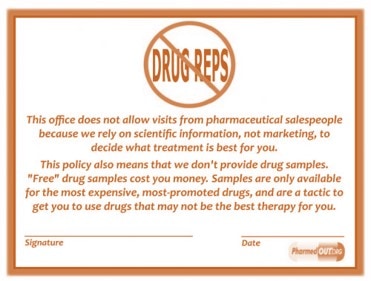Why I Avoid Drug Reps in My Office Like the Plague
There isn’t a week that goes by that I don’t see them lurking near our medication samples closet, but I walk by at double step and haven’t talked to one in many years. They are drug reps, a fixture of modern medicine. The last one I spoke to was from the maker of Oxycontin and it wasn’t pretty.
My last conversation with the Oxycontin rep came in the midst of a public health crisis created by the company that made the drug. Starting in the early 2000’s Purdue Pharma figured out an amazing business model that soon every drug company in the world would follow-re-swizzle junk and call it gold. They took a 90 year old drug called oxycodone, a powerful narcotic, put in a new binder that made it sustained release (meaning it would dissolve more slowly in the stomach) and got a new FDA approval. It was really a business master stroke, in that they knew oxycodone worked to relieve pain, so the FDA approval was cheap and fast. Oxycontin (long-acting oxycodone) was born. There was one little, minuscule problem, oxycodone was an addictive narcotic and doctors had been trained and conditioned for the last several decades to avoid prescribing narcotics like the plague. So they did what many pharma companies do, they found a bunch of university experts to perform studies that made it look like the drug wasn’t addictive. I remember these seminars held at very swank restaurants where the theory was that since the narcotic would enter the bloodstream slowly, patients would never feel the “high” associated with a short acting narcotic that entered the bloodstream more quickly. This meant that Oxycontin was less addictive. There was just one other little problem, this was basically fiction.
Thus began the public health crisis that led to my last drug rep discussion. By the time he walked into my office that day complaining about the fact that his pharmacy data showed that we were under prescribing Oxycontin, we had been inundated with patients addicted to Oxycontin. Some family physicians had bought the university song and dance hook, line, and sinker. They had been prescribing Oxycontin to anyone who had pain for more than a month or two. The patients would then return and request higher and higher doses as the process of addiction overtook their body’s natural pain control physiology. By the time many would be referred to our office for non medication based treatments to control their pain, they would be on the equivalent of 10-30 Percocet pills a day!
So what did I say to this drug rep? “Get out of my office”. We then discussed the finer points of the fact that the prima facie evidence didn’t support his university rubber stamped thesis that this junk wasn’t addictive. It was highly addictive. In addition, it was so nasty that reports were beginning to come in that the local coroners were having difficulty with pain patients who were dying in their sleep. Why? Their narcotic levels sometimes got a bit too high and suppressed the patient’s ability to breathe. Suffice it to say that we had words. More importantly, as a physician, that day was a sea change for me. I would never look at the drug industry or it’s pretty reps in the same way again. Let’s just say that at that moment, like all children who eventually grow up, I noticed the strings in the puppet show and I could never again be amazed by it.
For a physician who sees patients in pain all day, unlike some of my colleagues who prescribe drugs that can save lives, all of the drugs in my field are to treat pain. With a large armament of non medication based therapies, outside of post-procedure pain, pain drugs have pretty much become obsolete in my practice. In fact, I think that a reliance on new pain drugs stunts the knowledge of doctors that do what I do. Combine that with the fact that I now can’t attend the show without staring at the strings (or sit through a drug rep lunch being shown graphs and charts) and you have a doctor that chooses to avoid drug reps.
The upshot? We have a medical care system that’s broken. Much of the continuing medical education of doctors is driven and scripted by manufacturers producing drugs. The Oxycontin public health crisis is just the tip of the ice berg…

If you have questions or comments about this blog post, please email us at [email protected]
NOTE: This blog post provides general information to help the reader better understand regenerative medicine, musculoskeletal health, and related subjects. All content provided in this blog, website, or any linked materials, including text, graphics, images, patient profiles, outcomes, and information, are not intended and should not be considered or used as a substitute for medical advice, diagnosis, or treatment. Please always consult with a professional and certified healthcare provider to discuss if a treatment is right for you.

